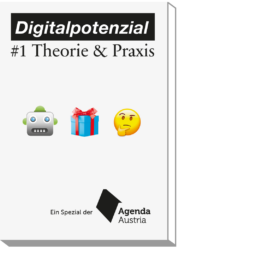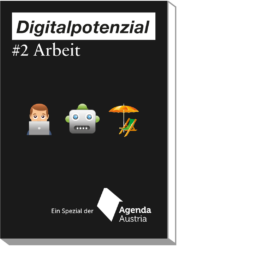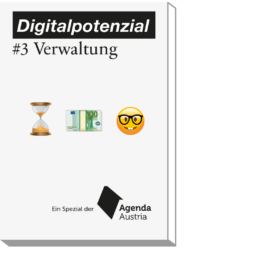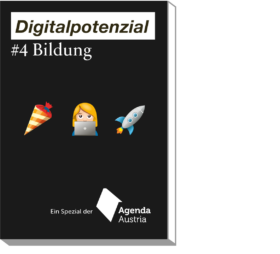Digitalpotenzial #1: Theorie & Praxis

- 01.01.2019
- Lesezeit ca. 5 min
Chancen und Risiken des digitalen Zeitalters
- Atkinson, R. D., Wu, J. (2017). „False Alarmism: Technological Disruption and the U.S. Labor Market, 1850 -2015“. ITIF, 08.05.2017. www.itif.org/publications/2017/05/08/false-alarmismtechnological-disruption-and-us-labor-market-1850-2015 (03.08.2017).
- Brynjolfsson, E., McAfee, A. (2014). The second machine age: Work, progress, and prosperity in a time of brilliant technologies. WW Norton & Company.
- Couto, J. (2015). „The Definitive Guide to Natural Language Processing“. MonkeyLearn, 29.10.2015. www.monkeylearn.com/blog/definitive-guidenatural-language-processing/ (28.07.2017).
- Koodiaapinen (2017). www.koodiaapinen.fi/en/ (05.10.2017).
- Kurzweil, R. (2005). The singularity is near: When humans transcend biology. Penguin.
- Leitner, M. (2017). „WienBot: Die Stadt Wien hat einen Chatbot“ Futurezone, 22.07.2017. www.futurezone.at/digital-life/wienbot-die-stadtwien-hat-einen-chatbot/246.709.043 (03.10.2017).
- Lewis, T. (2017). „Could 3D printing solve the organ transplant shortage“. The Guardian, 30.07.2017. www.theguardian.com/technology/2017/jul/30/will-3d-printing-solve-the-organ-transplant-shortage (03.10.2017).
- Luhn, H. P. (1958). The automatic creation of literature abstracts. IBM Journal of research and development, 2(2), 159–165. Lyman, P., Varian, H. R. (2003). How much information. Technical report, UC Berkeley. www.sims.berkeley.edu/research/projects/howmuch-info-2003/ (11.10.2018).
- Markoff, J. (2016). „Want to Buy a Self-Driving Car? Big-Rig Trucks May Come First“. New York Times, 17.05.2016. www.nytimes.com/2016/05/17/technology/want-to-buy-a-self-driving-car-trucks-may-come-first.html (05.10.2017).
- Manilla, L. (2016). „The Finnish Curriculum Reform 2016“. www.lindamannila.com/blogg/wp-content/uploads/p1-manilla.pdf (28.09.2017).
- Melchels, F. P., Domingos, M. A., Klein, T. J., Malda, J., Bartolo, P. J., Hutmacher, D. W. (2012). Additive manufacturing of tissues and organs. Progress in Polymer Science, 37(8), 1079–1104.
- Moore, G. E. (1998). Cramming more components onto integrated circuits. Proceedings of the IEEE, 82–85.
- Nilsson, N. J. (2009). The quest for artificial intelligence. Cambridge University Press.
- OwnYourData (2017). www.ownyourdata.eu/presse-ecke/ (03.11.2017).
- Rakuten (2016). „Teaching Coding Through Storytelling“. 19.04.2016. www.rakuten.today/blog/coding-through-storytelling.html (05.10.2017).
- Reece, A. G., Danforth, C. M. (2017). Instagram photos reveal predictive markers of depression. EPJ Data Science, 6(1), 15.
- Simonite, T. (2017). „Do We Need a Speedometer for Artificial Intelligence?“. Wired, 30.08.2017. www.wired.com/story/do-we-need-a-speedometer-forartificial-intelligence/?mbid=email_onsiteshare (12.10.2017).
- Wikipedia (2017). „Recht auf Vergessenwerden“. www.de.wikipedia.org/wiki/Recht_auf_Vergessenwerden (03.11.2017).
- Xing, B., Gao, W. J. (2014). Cuckoo Inspired Algorithms, in: Xing, B., Gao, W. J. (Hrsg.), Innovative computational intelligence: a rough guide to 134 clever algorithms, S. 105–121. Springer International Publishing
Weiter zum Band Digitalpotenzial #2: Arbeit >>
Mehr interessante Themen
Digitalpotenzial #1: Theorie & Praxis
Chancen und Risiken des digitalen Zeitalters
Zeiten großen technologischen Wandels sind Zeiten großer Verunsicherung. Dies gilt auch für die Digitalisierung. Wir Menschen fürchten uns vor Massenarbeitslosigkeit und hyperintelligenten Maschinen, die unser Leben bestimmen. Technologischer Wandel bringt aber auch enorme Möglichkeiten und Chancen, die von der Angst vor Veränderung verdeckt
Digitalpotenzial #2: Arbeit
Die Arbeitswelt von morgen (und übermorgen)
Die Digitalisierung macht vielen Menschen Angst. Ein Großteil hat Sorge, durch neue Technologien den Job zu verlieren. Ein seriöser Blick auf die Zukunft der Arbeit zeigt aber, dass jede technologische Revolution neue, zusätzliche Arbeitsplätze hervorgebracht hat. Welche Veränderungen uns erwarten – und warum diese keineswegs nur negativ sei
Digitalpotenzial #3: Verwaltung
Was Österreich von Estlands digitaler Verwaltung lernen kann
Viele Staaten stehen dem Wunsch des Bürgers nach zeitgemäßen Dienstleistungen ratlos gegenüber. Estland, ein kleines Land im Baltikum, hat vorgemacht, wie digitale Verwaltung aussehen kann.
Digitalpotenzial #4: Bildung
Raus aus der Kreidezeit – neu denken lernen
Neue Technologien erfordern und ermöglichen ein neues Denken. Daraus ergeben sich auch neue Wege in der Bildung. Es wird Zeit, dass wir uns auf die Reise machen.



